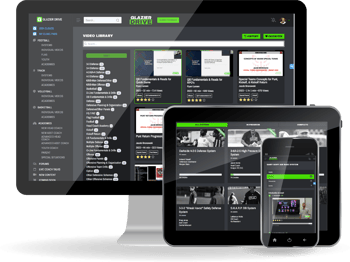FREE Online Flag Football Coaches Clinic
FREE Online Flag Football Coaches Clinic June 20-21
Glazier Clinics, the leader in football...
In today’s game, the option has become more of a lost art. While once lamented as the premier staple of some of the most dynamic offenses known, the option offenses have faded to the background. However, there are some schools that still believe in the once-dominant offensive scheme and are thriving.
Three of the more common ways to run the option scheme are the zone-read option, midline option, and power option. Each scheme has its advantages and disadvantages, in this quick article, we’ll cover which one might work better for you.
The first option scheme is a basic inside zone play. The play is designed for the Quarterback to read the defensive end on the line of scrimmage on the designated play side. It’s a simple read-assignment for the quarterback, if the defensive end takes the quarterback, the quarterback hands off the ball. If the defensive end takes running back, the quarterback pulls the ball.
This plays utilizes zone blocking from the offensive lineman. Their responsibility is to block away from the read guy (Defensive End) on the line of scrimmage. So the playside offensive tackle will execute a double team block with the offensive guard to the second level to block the linebacker.
The second option scheme is the midline option. This variation of the option requires the Quarterback to read the defensive tackle instead of the defensive end. The Quarterback progression read is the same as the zone-read option, if the defensive tackle takes the fullback/running back at the mesh point, the Quarterback pulls the ball. If the defensive tackle takes the Quarterback, then the Quarterback hands to the fullback/running back.
This plays also utilizes a form of zone blocking from the offensive lineman, but the isolated defender on this play is the defensive tackle. The offensive playside guard will execute a double team block to the second level. This makes the read for the QB clearer on the defensive tackle.
The last option scheme is the power option. This play differs from the two previously stated plays because there is no designed secondary option. The Quarterback is the primary ball carrier on this play.
The blocking is significantly different from the previous plays as well. The play-side linemen execute a down block and the backside guard pulls as the lead blocker for the Quarterback. The fullback/running back, who normally would be the secondary ballcarrier, execute a kick-out block on the first defensive player that shows on the end LOS.
There are various advantages and disadvantages to running each option concept. It truly depends on your players and their abilities. If you have a team that is undersized, yet agile incorporating a read option may work. If you have a bigger team with a very athletic Quarterback, midline or power options may appeal more to your team. Experiment with these concepts in practice and see what fits your overall offensive philosophy and schemes.
Tags: Offense, Quarterbacks, Blocking, Option Offense
Glazier Clinics, the leader in football...
FOR IMMEDIATE RELEASE GLAZIER CLINICS ACQUIRES THE RENO CLINIC OF CHAMPIONS
UNLIMITED COACHES - UNLIMITED IN-PERSON & ONLINE EDUCATION
The Glazier Season Pass gives all your coaches access to these resources:

Each clinic has 100+ sessions of practical Xs & Os for your entire staff. Network and brainstorm with some of the best speakers and coaches in the game.
Find a clinic near you
Join over 34,000 coaches on Glazier Drive, with 48 complete football systems, online clinics, 2,000+ videos, and much more.
Learn more about Drive